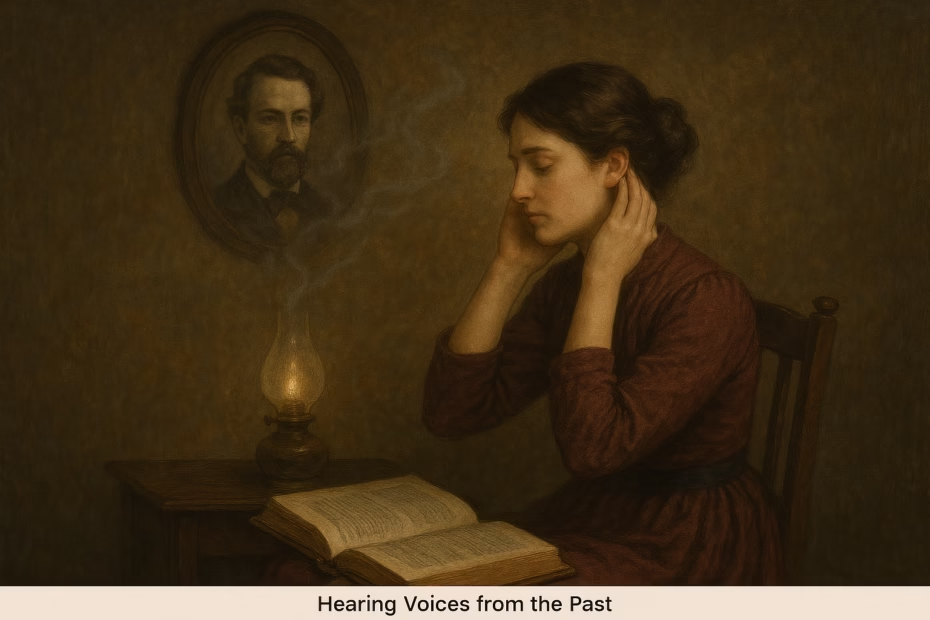This note provides a comprehensive overview of scientific research on hearing voices from the past, encompassing both the recovery of historical audio recordings and the study of auditory hallucinations, with a focus on cultural and psychological dimensions. The research spans multiple countries, including the USA, UK, Netherlands, India, and Ghana, and reflects both technological advancements and interdisciplinary insights.
Introduction to Hearing Voices from the Past
The concept of “hearing voices from the past” can be interpreted in two primary ways:
- Literal Recovery: Using technology to restore and digitize historical audio recordings, such as those from the 19th century, to hear actual voices preserved on physical media.
- Subjective Experience: Psychological and anthropological studies of auditory hallucinations, where individuals perceive voices as coming from historical figures, ancestors, or deceased relatives, often influenced by cultural and personal contexts.
This survey note details the research conducted, the countries involved, the methodologies, and the outcomes, highlighting successes and ongoing challenges.
Research on Recovering Historical Audio Recordings
This area focuses on technological efforts to recover sound from early audio artifacts, such as wax cylinders, tinfoil, and paper discs, which are often fragile and deteriorating.
Key Researchers and Institutions
- United States:
- Dr. Carl Haber and Vitaliy Fadeyev (Lawrence Berkeley National Laboratory):
- Developed the IRENE (Image, Reconstruct, Erase Noise, Etc.) system, a non-contact digital imaging technology adapted from particle physics detectors. This system uses high-powered microscopes to map the grooves of audio discs or cylinders and converts the spatial data into digital audio files.
- Notable achievements include restoring the earliest known recording of a human voice—a 10-second clip of “Au Clair de la Lune” from 1860 by Édouard-Léon Scott de Martinville—and early recordings of Alexander Graham Bell’s voice from 1885 Volta Laboratory discs.
- Collaborations include the Library of Congress, Smithsonian’s National Museum of American History, and other archives. Dr. Haber received a MacArthur “Genius” Grant in 2013 for his contributions.
- David Giovannoni and the First Sounds Collaborative:
- Recovered the 1860 phonautogram using optical scanning techniques at Lawrence Berkeley National Laboratory. This recording, originally a visual tracing on paper, was digitized and converted into audio, predating Edison’s phonograph by 17 years.
- Dr. Carl Haber and Vitaliy Fadeyev (Lawrence Berkeley National Laboratory):
- Other Institutions:
- Yale University’s Historical Sound Recordings collection holds approximately 280,000 recordings, including 78s, LPs, and cylinders, preserving early performances in music, drama, and literature.
- The UCSB Cylinder Audio Archive and Belfer Cylinders Digital Connection provide digitized access to over 10,000 and 1,600 cylinder recordings, respectively, featuring popular songs, vaudeville acts, and speeches from the late 1800s to early 1900s.
Methodology and Details
- The IRENE system’s non-contact approach is crucial for preserving fragile recordings that cannot be played physically without damage. It involves photographing the grooves with precision cameras and using software to translate groove patterns into sound waves.
- Challenges include dealing with damaged artifacts, unknown recording speeds, and formats with no surviving playback devices. Success depends on the condition of the medium and the precision of the imaging technology.
- The process has been credited with restoring historically valuable recordings, including folklore, music, speeches, and experimental sounds, making previously inaccessible voices audible.
Success and Impact
The research has been highly successful, with notable restorations like Bell’s voice earning recognition and adoption by major archives like the Library of Congress. This work ensures the preservation of cultural heritage, allowing future generations to hear voices from the past.
Research on Auditory Hallucinations and Cultural Voice-Hearing
This area explores the subjective experience of hearing voices, including those perceived as coming from the past, within psychological and anthropological frameworks. It emphasizes cultural variations and their implications for mental health.
Key Researchers and Projects
- United Kingdom:
- Hearing the Voice Project (Durham University, 2012–2022):
- Funded by the Wellcome Trust, this interdisciplinary project studied voice-hearing from personal, scientific, cultural, literary, and spiritual perspectives. Key outputs include the “Twelve Findings” brochure, available at Hearing the Voice Findings, summarizing insights from over a decade of research.
- Findings include a 2013 survey of 153 voice-hearers, where 81% reported hearing multiple voices, some described as characterful or linked to past events. The project also collaborated with the Edinburgh International Book Festival on “Writers’ Inner Voices,” exploring writers’ experiences, accessible at Writers’ Inner Voices.
- An online exhibition, hosted at Hearing Voices Exhibition, explores voice-hearing from multiple angles, including historical and cultural contexts.
- Hearing the Voice Project (Durham University, 2012–2022):
- United States:
- Tanya Luhrmann (Stanford University):
- Conducted a comparative study published in the British Journal of Psychiatry, comparing voice-hearing experiences in psychotic disorders across the USA, India, and Ghana. The study, detailed at Stanford Report, found that in the USA, voices are often harsh and threatening, while in India and Ghana, they are more benign and playful, sometimes perceived as ancestral or spiritual.
- The research involved interviewing 60 adults diagnosed with schizophrenia—20 each in San Mateo, California; Accra, Ghana; and Chennai, India—highlighting cultural “invitations” shaping voice experiences.
- Phil Corlett and Albert Powers (Yale University):
- Studied voice-hearing in psychics versus schizophrenia patients, finding that psychics often perceive voices as historical or deceased figures. Their 2017 Science paper used brain scans to identify neural correlates, showing similar activation patterns in both groups.
- Tanya Luhrmann (Stanford University):
- Netherlands:
- Marius Romme and Sandra Escher:
- Pioneered the Hearing Voices Movement (HVM) in the 1980s, studying voice-hearing as a human experience rather than solely a symptom of illness. Their work, detailed in various publications, includes cases where voices are interpreted as historical or symbolic figures tied to personal trauma or culture.
- Developed the Maastricht Hearing Voices Interview to map voice origins, finding some linked to past events or figures, with the HVM spreading to 35 countries.
- Marius Romme and Sandra Escher:
- India and Ghana:
- Collaborative studies, often part of Luhrmann’s research, explored how cultural contexts shape voice-hearing, with findings suggesting voices are more likely to be seen as benevolent in these settings compared to the USA.
Methodology and Details
- Research methods include interviews, surveys, and brain imaging (e.g., PET, fMRI) to explore the phenomenology of voice-hearing. For example, Luhrmann’s study used structured interviews to compare voice content and emotional impact across cultures.
- Cultural variation is a key focus, with studies showing that in collectivist cultures like India and Ghana, voices may remind people of friends and family or be considered playful, while in individualistic cultures like the USA, they are often distressing and linked to mental illness.
- The Hearing the Voice project also examined literary and historical contexts, such as writers hearing characters’ voices, suggesting a broader cultural narrative around voice-hearing.
Success and Impact
- These studies have advanced understanding of voice-hearing as a complex, culturally influenced phenomenon, with prevalence estimates ranging from 3–15% of people. They have informed therapeutic approaches, such as teaching individuals to interact with voices in less distressing ways, as part of the HVM.
- However, no research confirms that these voices are objectively “from the past”; they remain subjective experiences shaped by cultural and personal factors. Success is measured in terms of comprehension and clinical outcomes rather than literal verification.
Comparative Analysis: Success and Challenges
Historical Recordings:
- Success is evident in the restoration of significant recordings, with technologies like IRENE adopted by major archives. Challenges include dealing with damaged media and unknown recording speeds, but advancements continue to improve outcomes.
- Table 1 below summarizes key details:
| Researcher/Institution | Country | Technology/Method | Key Achievement | Challenges |
| Carl Haber, Lawrence Berkeley | USA | IRENE system (digital imaging) | Restored Bell’s voice, 1860 phonautogram | Damaged artifacts, unknown speeds |
| David Giovannoni, First Sounds | USA | Optical scanning | Recovered 1860 phonautogram | Fragility of media |
| Yale Historical Sound Recordings | USA | Preservation and digitization | 280,000 recordings preserved | Maintaining large collections |
Auditory Hallucinations:
- Success lies in understanding cultural variations and developing coping strategies, with projects like Hearing the Voice and HVM making significant contributions. Challenges include distinguishing hallucinations from cultural beliefs and avoiding pathologizing, especially in non-Western contexts.
- Table 2 below summarizes key details:
| Researcher/Project | Country | Focus | Key Finding | Challenges |
| Hearing the Voice | UK | Phenomenology, culture | 81% hear multiple voices, some historical | Verifying subjective experiences |
| Tanya Luhrmann | USA, India, Ghana | Cultural variation | USA voices harsh, India/Ghana benign | Cultural bias in interpretation |
| Marius Romme, HVM | Netherlands | Coping strategies | Voices tied to trauma, historical figures | Standardizing treatment across cultures |
Conclusion
Research on hearing voices from the past shows significant progress in both recovering historical audio and understanding auditory hallucinations. The USA leads in technological recovery, with successful restorations like Bell’s voice, while the UK, Netherlands, India, and Ghana contribute to cultural and psychological insights. While historical recordings offer literal access to past voices, hallucinations remain subjective, shaped by culture, with ongoing efforts to improve understanding and treatment. The evidence leans toward success in preservation and comprehension, but challenges persist in verifying subjective experiences and addressing cultural differences.
Key Citations
- Restoring Historical Audio Recordings HIBAR Research
- Hearing the Voice Project Findings
- Writers’ Inner Voices Collaboration
- Hearing Voices Exhibition Online
- Stanford Report on Cultural Voice-Hearing
Read Another Article: What is Telepathy? And Method of Telepathy?





